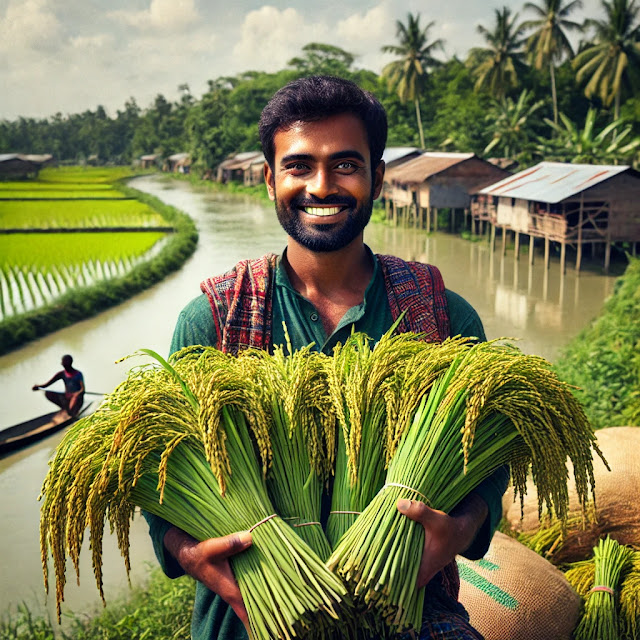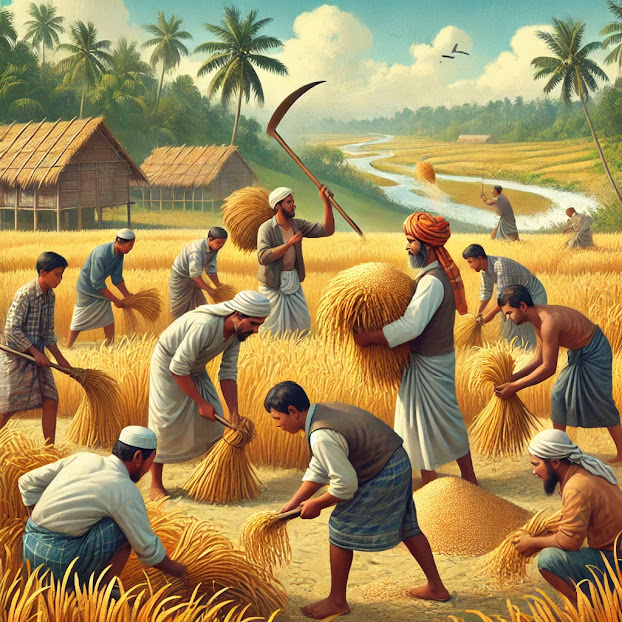The Lifeblood of Bangladesh’s Economy
Bangladesh is a country known for its rich cultural heritage, thriving textile industry, and dynamic urban centers. However, at the heart of its economy lies a deeply ingrained tradition of farming, where over 40% of the population depends on agriculture for their livelihood. The rural areas of Bangladesh, home to millions of farmers, are a testament to the resilience, hard work, and enduring spirit of its people.
Farming in Bangladesh is not just a way of life; it is the cornerstone of the country’s agricultural success, providing both food and income for the nation. From the vast, fertile plains of the Ganges Delta to the riverbanks and hilly regions of the country, Bangladeshi farmers are involved in a wide range of cultivation practices, from rice and jute to fruits and vegetables.
This blog post explores the cultivation practices of Bangladeshi farmers, the unique challenges they face, and the critical role they play in both the economy and society. It is an homage to their dedication and a glimpse into the agricultural world that sustains millions.
The Agricultural Landscape of Bangladesh
Bangladesh is home to one of the world’s most fertile river deltas, which makes it a prime location for agriculture. The country’s vast network of rivers and tributaries, combined with a subtropical monsoon climate, provides ideal conditions for crop cultivation. The landscape is dotted with lush green fields that come alive with seasonal farming activity, particularly during the monsoon months.
Rice is the most important crop in Bangladesh, providing a staple food source for millions of people. The country grows two main types of rice: Boro rice, which is grown in the dry season (from November to April), and Aman rice, grown during the wet monsoon season (from June to October). Together, these crops make up the majority of Bangladesh’s agricultural output.
However, the agricultural landscape of Bangladesh is diverse, with farmers also growing jute, vegetables, fruits, and various pulses. Jute, in particular, has played a crucial role in the economy, once being dubbed the “golden fiber” of Bangladesh due to its high demand in international markets.
The Cultivation Process: A Journey of Dedication
For a Bangladeshi farmer, cultivating crops is a year-round endeavor that requires dedication, hard work, and an intricate knowledge of the land and climate. The cultivation process is broken down into several key stages that span the entire agricultural calendar.
1. Land Preparation
The first step in the cultivation process is land preparation. Depending on the type of crop, farmers begin by plowing the land to aerate the soil and prepare it for sowing. In the case of rice cultivation, the fields are flooded with water, creating ideal conditions for rice seedlings. Land preparation also involves the application of organic or chemical fertilizers to enhance soil fertility.
2. Seed Selection
Choosing the right seeds is crucial for ensuring a successful harvest. Farmers in Bangladesh rely on a combination of traditional knowledge and modern agricultural practices to select the best seeds for their crops. In rice cultivation, for example, farmers select high-quality varieties that are resistant to diseases, pests, and environmental stress, particularly flooding and drought.
3. Sowing and Transplanting
Sowing and transplanting are key stages in the cultivation of crops. For rice, sowing begins with preparing seedlings in nurseries, where they are allowed to grow for several weeks. Once the seedlings are strong enough, they are transplanted into the flooded fields. This is a labor-intensive process that involves transplanting rice seedlings by hand, with each seedling carefully placed to ensure a healthy yield.
In other crops like vegetables and pulses, sowing is done directly into the soil, using traditional hand tools or mechanized equipment depending on the scale of the farm.
4. Crop Maintenance
Once the crops are planted, maintaining them becomes a full-time job. Farmers in Bangladesh must regularly inspect their fields to ensure they are free from pests and diseases. This often involves using pesticides, though many farmers are now turning to organic methods to protect their crops.
Water management is also crucial for rice cultivation. Farmers must regulate water levels to avoid drowning their crops or allowing them to dry out. In the case of vegetables and fruits, irrigation techniques are used to ensure crops receive the right amount of water, especially during dry spells.
5. Harvesting and Post-Harvest Care
The final step in the cultivation process is harvesting. Harvesting time varies depending on the type of crop, but it is typically a time of intense labor. For rice, farmers use sickles to cut the rice stalks, which are then gathered and dried in the sun. After drying, the rice is threshed to separate the grains from the stalks. The grains are then cleaned and stored for consumption or sale.
For fruits, vegetables, and jute, harvesting is similarly done by hand, with care taken to ensure the crops are handled gently to avoid damage.
Challenges Faced by Bangladeshi Farmers
While farming is central to the survival and prosperity of Bangladesh, the country’s farmers face numerous challenges that threaten their livelihoods. From unpredictable weather patterns to financial constraints, these challenges demand resilience and adaptability.
1. Climate Change and Weather Extremes
One of the most significant challenges faced by farmers in Bangladesh is the impact of climate change. Changes in weather patterns, rising temperatures, and erratic rainfall have made farming more unpredictable. The monsoon season, once a reliable source of water for rice farming, now arrives unpredictably, and sometimes, too much rain causes flooding, destroying crops.
Conversely, dry spells can lead to droughts, causing severe water shortages for crops like rice, which require consistent flooding. Floods, storms, and cyclones are also frequent, adding to the unpredictability of farming in Bangladesh.
2. Soil Degradation and Water Scarcity
Soil degradation is another pressing issue for Bangladeshi farmers. Overuse of chemical fertilizers and pesticides has led to the depletion of soil nutrients, making it difficult for farmers to maintain healthy crops. Furthermore, the excessive use of water in rice farming has led to concerns over water scarcity in many regions.
3. Economic Pressures and Debt
Farmers in Bangladesh often face economic hardships due to fluctuating crop prices, high input costs, and poor access to credit. Many farmers have limited access to modern farming equipment and technology, making it difficult to improve productivity. Moreover, the cost of fertilizers, seeds, and pesticides can add significant financial strain, pushing farmers into debt 

4. Access to Technology and Innovation
While modern agricultural techniques and technologies have the potential to improve farming efficiency, many Bangladeshi farmers still rely on traditional practices. Limited access to high-yield seeds, mechanized equipment, and expert advice means that many farmers struggle to improve their farming methods.
The Role of Government and NGOs in Supporting Farmers
To tackle the challenges faced by farmers, the government of Bangladesh, along with non-governmental organizations (NGOs), has implemented a variety of support programs aimed at improving agricultural productivity and ensuring the livelihood of farmers.
1. Government Subsidies and Support
The Bangladeshi government provides subsidies for fertilizers, seeds, and irrigation systems to help reduce the financial burden on farmers. Agricultural extension services are also offered, providing farmers with the knowledge and skills necessary to improve crop yields and sustainability.
2. NGO Initiatives
Non-governmental organizations play a crucial role in supporting rural farmers by providing training, financial aid, and access to improved farming technologies. They also promote sustainable farming practices, such as organic farming and climate-resilient crops, which can help mitigate the effects of climate change.
Sustainable Farming Practices: A Path Forward
The future of farming in Bangladesh lies in embracing sustainable agricultural practices. This includes adopting climate-resilient crop varieties, improving water management systems, and transitioning to organic farming practices. Many farmers are already adopting sustainable techniques, such as crop rotation, reduced pesticide use, and integrated pest management, to ensure long-term soil health and crop productivity.
By focusing on sustainability, farmers can help mitigate the effects of climate change while also increasing their income and food security.
Conclusion: The Backbone of Bangladesh’s Agriculture
The Bangladeshi farmer remains the backbone of the country’s agricultural sector. Through their hard work, dedication, and resilience, they continue to cultivate the land, providing food, income, and employment for millions. Despite the challenges they face, farmers are adapting to change and embracing new technologies to improve productivity and sustainability.
As Bangladesh moves towards a future shaped by climate change, innovation, and economic pressures, the role of the farmer will remain as vital as ever. Supporting farmers through better policies, education, and access to resources is key to ensuring the continued success of Bangladesh’s agricultural sector.
The story of the Bangladeshi farmer is one of struggle, perseverance, and hope—a testament to the enduring spirit of rural Bangladesh and the crucial role these farmers play in the country’s development












Comments
Post a Comment